Monday 28 December, 2015, 17:39 - Equipment Reviews
Posted by Administrator
Making phone calls in the UK has rarely been as cheap as it is today. Most mobile contracts provide almost limitless free UK calls and even low cost pay-as-you-go services such as those provided by GiffGaff offer plenty of bundled call minutes.Posted by Administrator
However, calling from fixed-lines remains relatively expensive. Though the fixed line operators provide packages with bundles of calls, these are surprisingly costly and without these packages, the call rates are often high. The table below sets out the relative costs of different phone (and broadband) packages from some of the bigger suppliers, based on someone making one hour of phone calls a month (to a fixed line), an hour per week and one hour of phone calls a day (to a fixed line).
| Operator | Cost per minute | Cost per month | |||
|---|---|---|---|---|---|
| Unlimited Package* | (60 mins per month) | (60 mins per week) | (60 mins per day) | ||
| BT | 9.58p | £7.50 | £5.75 | £24.91 | £174.95 |
| PlusNet | 7.49p | £9.00 | £5.40 | £23.40 | £164.36 |
| Sky | 9.50p | £5.00 | £5.70 | £24.70 | £173.49 |
| TalkTalk | 11.5p | £10.00 | £6.90 | £29.90 | £210.02 |
| Virgin Media | 10.6p | £8.00 | £6.36 | £27.56 | £193.58 |
* Additional monthly cost for unlimited calls over and above standard package
It is absolutely clear, therefore, that anyone who makes more than cursory use of their fixed line (to call other fixed lines) should be taking the operators' all inclusive packages for calls as the break-even point is arond the one hour of calls per month level (or two minutes per day).
But the situation becomes far more complicated in the case that anyone wishes to make international calls whether from a fixed line or a mobile. International calls are generally far more expensive than domestic fixed line calls and though some operators offer bundles of minutes for some destinations, and even though there are a myriad of calling cards and other methods for reducing the cost of calls, they tend to be complicated to use.
At the Wireless Waffle HQ, calls to UK fixed lines, as well as to international destinations, are a day-to-day requirement and the cost of these calls was becoming significant. At the same time, a method which allows these calls to be made whilst being so user friendly that it was no different to a standard phone was essential to ensure that the rest of the residents of the HQ did not have to dial short-codes or press extra buttons when making a call.
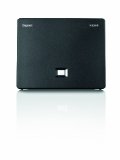 The answer came in the form of the Gigaset N300IP DECT base station, teamed with a matching DECT handset (such as the Gigaset A510). This canny device allows a standard fixed-line and a Voice over IP (VoIP) line to be integrated seamlessly. What this means is that incoming calls (on either line) ring the phone as usual, but that outgoing calls go via the VoIP line. VoIP has been around for a long time - it uses the Internet to make phone calls. Years ago, the quality was poor and calls somewhat unreliable but today with a reasonable broadband connection, the quality is excellent and most importantly, the call rates are cheap - very cheap.
The answer came in the form of the Gigaset N300IP DECT base station, teamed with a matching DECT handset (such as the Gigaset A510). This canny device allows a standard fixed-line and a Voice over IP (VoIP) line to be integrated seamlessly. What this means is that incoming calls (on either line) ring the phone as usual, but that outgoing calls go via the VoIP line. VoIP has been around for a long time - it uses the Internet to make phone calls. Years ago, the quality was poor and calls somewhat unreliable but today with a reasonable broadband connection, the quality is excellent and most importantly, the call rates are cheap - very cheap. The VoIP provider used at the WW HQ is Miso Comms. Whilst there are endless VoIP providers available, some of who are even cheaper than Miso for certain calls, the company is run by a team of telecommunications professionals who really know what they are doing. Of course they're out to make a profit just as anyone else, but with such a credible background, the service and prices are both excellent. Most international calls are under 2p per minute and UK fixed line calls are just 0.63p per minute (e.g. 38 pence per hour) and the call quality is far better than many VoIP services that we at WW have tried in the past. What's more, in addition to using their service on the Gigaset unit, it can also be programmed into mobile phones (using the SIP protocol) and an app such as CSipSimple such that these low call rates can also be used from a mobile device connected to, for example WiFi. This means the low cost calls can be made from just about anywhere with a decent internet connection and not just home.
The VoIP provider used at the WW HQ is Miso Comms. Whilst there are endless VoIP providers available, some of who are even cheaper than Miso for certain calls, the company is run by a team of telecommunications professionals who really know what they are doing. Of course they're out to make a profit just as anyone else, but with such a credible background, the service and prices are both excellent. Most international calls are under 2p per minute and UK fixed line calls are just 0.63p per minute (e.g. 38 pence per hour) and the call quality is far better than many VoIP services that we at WW have tried in the past. What's more, in addition to using their service on the Gigaset unit, it can also be programmed into mobile phones (using the SIP protocol) and an app such as CSipSimple such that these low call rates can also be used from a mobile device connected to, for example WiFi. This means the low cost calls can be made from just about anywhere with a decent internet connection and not just home.The Gigaset units will set you back around œ70 for the base-station and the handset together which amounts to around a full year's subscription to unlimited calls from the main phone providers. But for international calls, the savings clock up virtually immediately. In most cases, anyone making 60 minutes per month of international calls will pay for the equipment in less than a year and in many cases, much more quickly. If you just put the CSipSimple app on your phone, the savings are instantaneous. If you have family around the world (or around the corner), why not give VoIP a go.
1 comment
( 768 views )
| permalink
| 



 ( 3.1 / 1934 )
( 3.1 / 1934 )




 ( 3.1 / 1934 )
( 3.1 / 1934 )
Whilst Wireless Waffle is branching out into equipment reviews the time seems right to give a plug to the snappily titled TP-Link WR702N wireless N nano router.
What is it? It's a small (hand-sized) wireless router that can be configured to do a number of jobs. In essence it's a wired network connection and a wireless network connection in a single box that can be configured in a number of ways. For example:
The device deserves a special mention because of both its flexibility in being able to do a number of different tasks, but most importantly because of its usefulness. The only downside is that it can be fiddly to set-up (see the CNET review of the device for more info on this).
 Imagine, if you can, being in an overseas hotel where there is a free wired internet connection but no WiFi and all you have to connect to the internet are your phone, a tablet and a laptop that's so slim and sexy that it doesn't have a wired network socket. You could turn on data roaming, but we all know how extortionate that is. You could get high, get moving, get naked and get clear to see if you can snag a signal from a rogue, unencrypted WiFi connection. You could wander down the street to the nearest coffee shop and hope they have WiFi. Or... you could have brought your TP-Link WR702N with you and plug it into the wired connection. Before you can say 'hey espresso', you have a ready made WiFi connection and both your phone and tablet are ready to update your Facebook profile!
Imagine, if you can, being in an overseas hotel where there is a free wired internet connection but no WiFi and all you have to connect to the internet are your phone, a tablet and a laptop that's so slim and sexy that it doesn't have a wired network socket. You could turn on data roaming, but we all know how extortionate that is. You could get high, get moving, get naked and get clear to see if you can snag a signal from a rogue, unencrypted WiFi connection. You could wander down the street to the nearest coffee shop and hope they have WiFi. Or... you could have brought your TP-Link WR702N with you and plug it into the wired connection. Before you can say 'hey espresso', you have a ready made WiFi connection and both your phone and tablet are ready to update your Facebook profile!
Imagine moving into a new house to find that the WiFi connection covers every room except the kitchen. How will you read the morning e-newspaper over your coffee without WiFi in the kitchen? Simple, get your TP-Link WR702N and place it somewhere between the kitchen and your existing WiFi hub and before you can say 'special-k presto' you're back online.
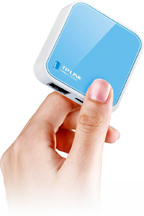 Imagine discovering that you've missed the latest thrilling installement of 'Britain's Got Strictly Celebrity Antique Hunter On Ice'. Your satellite set-top-box has the option to run 'i-TV-Player-on-Demand' but it's only got a wired internet connection and you only have WiFi at home. Just break out the trusty TP-Link WR702N and before you can say 'tres fresco' you're streaming over-the-top video like a pro.
Imagine discovering that you've missed the latest thrilling installement of 'Britain's Got Strictly Celebrity Antique Hunter On Ice'. Your satellite set-top-box has the option to run 'i-TV-Player-on-Demand' but it's only got a wired internet connection and you only have WiFi at home. Just break out the trusty TP-Link WR702N and before you can say 'tres fresco' you're streaming over-the-top video like a pro.
Finally, imagine trying to build a tower of plastic boxes that reaches the moon, to find you're a centimetre short. Just grab your TP-Link WR702N and put it on top and 'pay tesco' you've made it to the lunar surface.
Seriously though, for anyone who travels a lot and stays in hotels with no WiFi, who has patchy WiFi coverage at home, or wants to connect their blu-ray player to the internet to use Netflix, this little beauty does a great job and comes with the Wireless Waffle, 'Recommended Useful Broad Band Internet Signal Heighthener' seal of approvalness. Oops, that was supposed to be serious and look what happened. Maybe Wireless Waffle should just stick to being facetious.
What is it? It's a small (hand-sized) wireless router that can be configured to do a number of jobs. In essence it's a wired network connection and a wireless network connection in a single box that can be configured in a number of ways. For example:
- It can add a WiFi connection to a normal wired network or internet connection.
- It can share an existing wired internet connection with multiple devices or users.
- It can extend the range of an existing WiFi network.
- It can act as a WiFi client, to give a wireless connection to things that don't have one (e.g. TV set-top-boxes).
The device deserves a special mention because of both its flexibility in being able to do a number of different tasks, but most importantly because of its usefulness. The only downside is that it can be fiddly to set-up (see the CNET review of the device for more info on this).
 Imagine, if you can, being in an overseas hotel where there is a free wired internet connection but no WiFi and all you have to connect to the internet are your phone, a tablet and a laptop that's so slim and sexy that it doesn't have a wired network socket. You could turn on data roaming, but we all know how extortionate that is. You could get high, get moving, get naked and get clear to see if you can snag a signal from a rogue, unencrypted WiFi connection. You could wander down the street to the nearest coffee shop and hope they have WiFi. Or... you could have brought your TP-Link WR702N with you and plug it into the wired connection. Before you can say 'hey espresso', you have a ready made WiFi connection and both your phone and tablet are ready to update your Facebook profile!
Imagine, if you can, being in an overseas hotel where there is a free wired internet connection but no WiFi and all you have to connect to the internet are your phone, a tablet and a laptop that's so slim and sexy that it doesn't have a wired network socket. You could turn on data roaming, but we all know how extortionate that is. You could get high, get moving, get naked and get clear to see if you can snag a signal from a rogue, unencrypted WiFi connection. You could wander down the street to the nearest coffee shop and hope they have WiFi. Or... you could have brought your TP-Link WR702N with you and plug it into the wired connection. Before you can say 'hey espresso', you have a ready made WiFi connection and both your phone and tablet are ready to update your Facebook profile!Imagine moving into a new house to find that the WiFi connection covers every room except the kitchen. How will you read the morning e-newspaper over your coffee without WiFi in the kitchen? Simple, get your TP-Link WR702N and place it somewhere between the kitchen and your existing WiFi hub and before you can say 'special-k presto' you're back online.
 Imagine discovering that you've missed the latest thrilling installement of 'Britain's Got Strictly Celebrity Antique Hunter On Ice'. Your satellite set-top-box has the option to run 'i-TV-Player-on-Demand' but it's only got a wired internet connection and you only have WiFi at home. Just break out the trusty TP-Link WR702N and before you can say 'tres fresco' you're streaming over-the-top video like a pro.
Imagine discovering that you've missed the latest thrilling installement of 'Britain's Got Strictly Celebrity Antique Hunter On Ice'. Your satellite set-top-box has the option to run 'i-TV-Player-on-Demand' but it's only got a wired internet connection and you only have WiFi at home. Just break out the trusty TP-Link WR702N and before you can say 'tres fresco' you're streaming over-the-top video like a pro.Finally, imagine trying to build a tower of plastic boxes that reaches the moon, to find you're a centimetre short. Just grab your TP-Link WR702N and put it on top and 'pay tesco' you've made it to the lunar surface.
Seriously though, for anyone who travels a lot and stays in hotels with no WiFi, who has patchy WiFi coverage at home, or wants to connect their blu-ray player to the internet to use Netflix, this little beauty does a great job and comes with the Wireless Waffle, 'Recommended Useful Broad Band Internet Signal Heighthener' seal of approvalness. Oops, that was supposed to be serious and look what happened. Maybe Wireless Waffle should just stick to being facetious.
Wednesday 25 September, 2013, 11:35 - Radio Randomness, Spectrum Management, Equipment Reviews
Posted by Administrator
In the past, Wireless Waffle has discussed various things that cause radio interference but which are not supposed to including, for example Power Line Telecommunications devices. This time around it's the turn of a Class T audio amplifier to come under the spotlight.Posted by Administrator
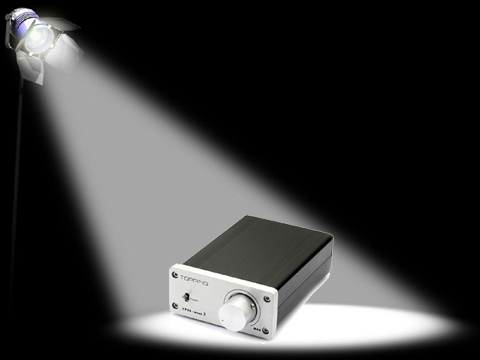
Class T amplifiers are really Class D amplifiers but are supposedly more efficient. Any clearer? No, probably not. The idea behind these types of audio amplifiers (noting that the Class D principal is also used in some radio transmitters too) is that instead of amplifying an analogue signal in an analogue way, such that the output voltage is just an amplified version of the input voltage, they switch the output voltage on and off at a frequency higher than the audio signal, and then use a filter on the output to smooth the square wave that they produce back into a nice analogue signal. This method is known as pulse width modulation.
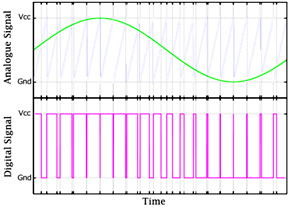 This switching technique is exactly the same one that is used in the majority of modern power supplies (SMPS) and has the prime advantage that as the transistors that do the switching are either turned on or off, they are never in some intermediate state where they would have to act as a resistor and in doing so dissipate power and heat. So they are highly efficient and it is possible to generate audio with over 90% efficiency meaning that more of the power is converted to sound and less is lost as heat, which is, after all, a very admirable quality.
This switching technique is exactly the same one that is used in the majority of modern power supplies (SMPS) and has the prime advantage that as the transistors that do the switching are either turned on or off, they are never in some intermediate state where they would have to act as a resistor and in doing so dissipate power and heat. So they are highly efficient and it is possible to generate audio with over 90% efficiency meaning that more of the power is converted to sound and less is lost as heat, which is, after all, a very admirable quality.As with switch mode power supplies a good filter is critical in ensuring that none of the original square waves find their way to the output. Square waves are very good at producing harmonics and therefore are equally good at generating radio signals and, of course, radio interference. There have been many cases of switch mode power supplies causing such radio interference and their use in, for example, LED lighting, means that the number of possible sources of interference is ever increasing.
The main problem is that, in many cases, the device will work without the filter fitted - if (and only if) the device that it is powering is not too fussy about all those square waves (e.g. an LED) or has a method of smoothing them out itself (e.g. a loudspeaker). A loudspeaker is basically a large inductor, which is what the filters in switching amplifiers also comprise. Feeding the nasty square waves on the output of the switcher directly into a loudspeaker will not result in a noticeable loss in fidelity (assuming the switching frequency is well above the audible frequency range), nor any particular loss of efficiency. So why fit the filter? To stop radio interference, that's why.
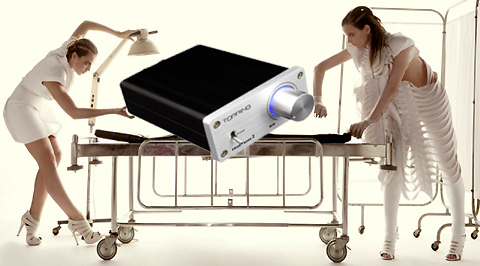
So step up to the examination table, the Topping TP20-MK2 Class T Digital Mini Amplifier
In cases such as these, there is little that can be done. Other than taking the device apart and replacing the filter components with better ones (an idea that is not as daft as it sounds), the solution is to junk the device and use a traditional linear amplifier instead. Which is what has been done. Bye bye trendy, offendy Topping, hello dusty, trusty Sony.


